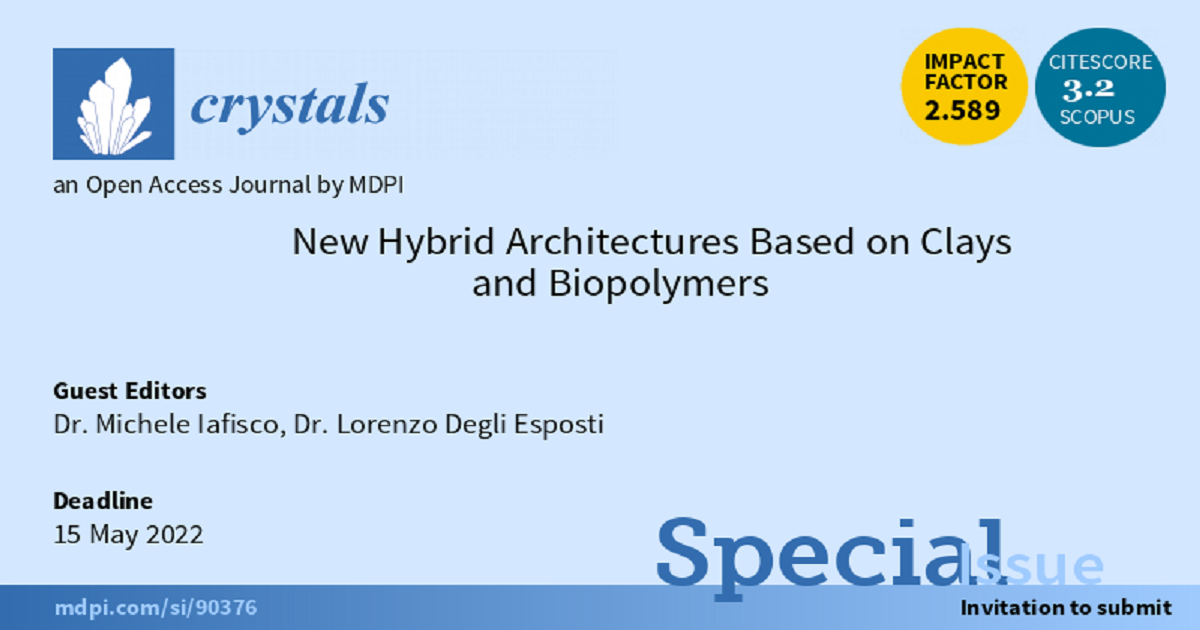- 2.4Impact Factor
- 5.0CiteScore
- 13 daysTime to First Decision
New Hybrid Architectures Based on Clays and Biopolymers
This special issue belongs to the section “Hybrid and Composite Crystalline Materials“.
Special Issue Information
Dear Colleagues,
Today, the term hybrid or biohybrid is widely used to describe composite materials resulting from the assembly of molecular and polymeric species of biological origin and inorganic solids of diverse structure and morphology assembled at the nanometer scale. These materials attract many scientists and engineers due to their extensive incidence in different application fields. They constitute an emerging and interdisciplinary research area involving life sciences, material sciences, and nanotechnology from environmental remediation to biomedical uses. The recent development of new nanohybrids produced by the combination at the nanometric scale of natural polymers and inorganic solids, i.e., bionanocomposites, is the basis to prepare a large number of bioinspired and biomimetic systems. The use of biopolymers therefore represents a major advantage in the field as these materials combine diverse biopolymers (proteins, lipids, polysaccharide, nucleic acids, etc.) with inorganic solids (silica, silicates, phosphates, carbonates, etc.), being of relevance due to their nontoxic, biocompatible, and biodegradable behavior. Therefore, these properties make biohybrids good candidates for use in a wide range of applications, such as food packaging, biomedicine (e.g., drug delivery, tissue engineering, artificial bone, genetic therapy), removal of pollutants, biosensing devices and bioreactors, etc. Of particular relevance are biohybrids in which the inorganic component is a silicate or aluminosilicate belonging to the clay mineral family (e.g., sepiolite, halloysite). Clays offer relevant properties afforded by their unique morphological and surface features that give rise to the enhancement of mechanical properties, and also favoring their assembly to the biopolymer matrix by hydrogen bonding through external silanol or aluminol groups (Si–OH, Al–OH) on clay surfaces. The preparation and physicochemical characterization of biohybrid materials from clays of different nature as well as other related inorganic solids, the evaluation of the properties of the biohybrid materials, and the study of their applicability in technological and industrial field represent topical and challenging issues.
Dr. Michele Iafisco
Dr. Lorenzo Degli Esposti
Guest Editors
Manuscript Submission Information
Manuscripts should be submitted online at www.mdpi.com by registering and logging in to this website. Once you are registered, click here to go to the submission form. Manuscripts can be submitted until the deadline. All submissions that pass pre-check are peer-reviewed. Accepted papers will be published continuously in the journal (as soon as accepted) and will be listed together on the special issue website. Research articles, review articles as well as short communications are invited. For planned papers, a title and short abstract (about 250 words) can be sent to the Editorial Office for assessment.
Submitted manuscripts should not have been published previously, nor be under consideration for publication elsewhere (except conference proceedings papers). All manuscripts are thoroughly refereed through a single-blind peer-review process. A guide for authors and other relevant information for submission of manuscripts is available on the Instructions for Authors page. Crystals is an international peer-reviewed open access monthly journal published by MDPI.
Please visit the Instructions for Authors page before submitting a manuscript. The Article Processing Charge (APC) for publication in this open access journal is 2100 CHF (Swiss Francs). Submitted papers should be well formatted and use good English. Authors may use MDPI's English editing service prior to publication or during author revisions.
Keywords
- Clays
- Biohybrid
- Biopolymers
- Halloysite
- Nanotubes
- Functional materials

Benefits of Publishing in a Special Issue
- Ease of navigation: Grouping papers by topic helps scholars navigate broad scope journals more efficiently.
- Greater discoverability: Special Issues support the reach and impact of scientific research. Articles in Special Issues are more discoverable and cited more frequently.
- Expansion of research network: Special Issues facilitate connections among authors, fostering scientific collaborations.
- External promotion: Articles in Special Issues are often promoted through the journal's social media, increasing their visibility.
- e-Book format: Special Issues with more than 10 articles can be published as dedicated e-books, ensuring wide and rapid dissemination.

